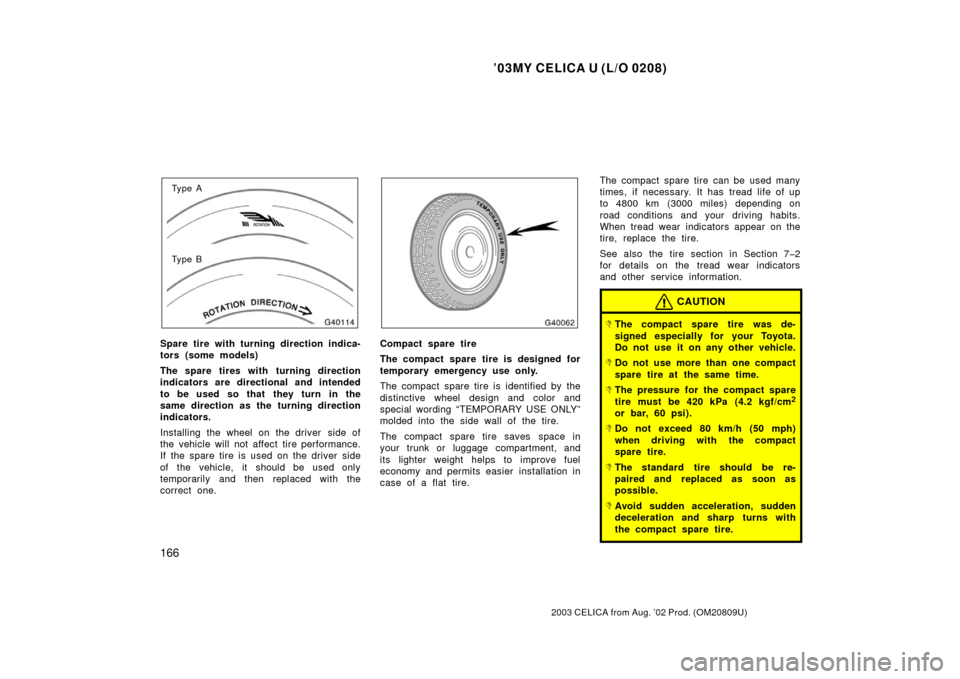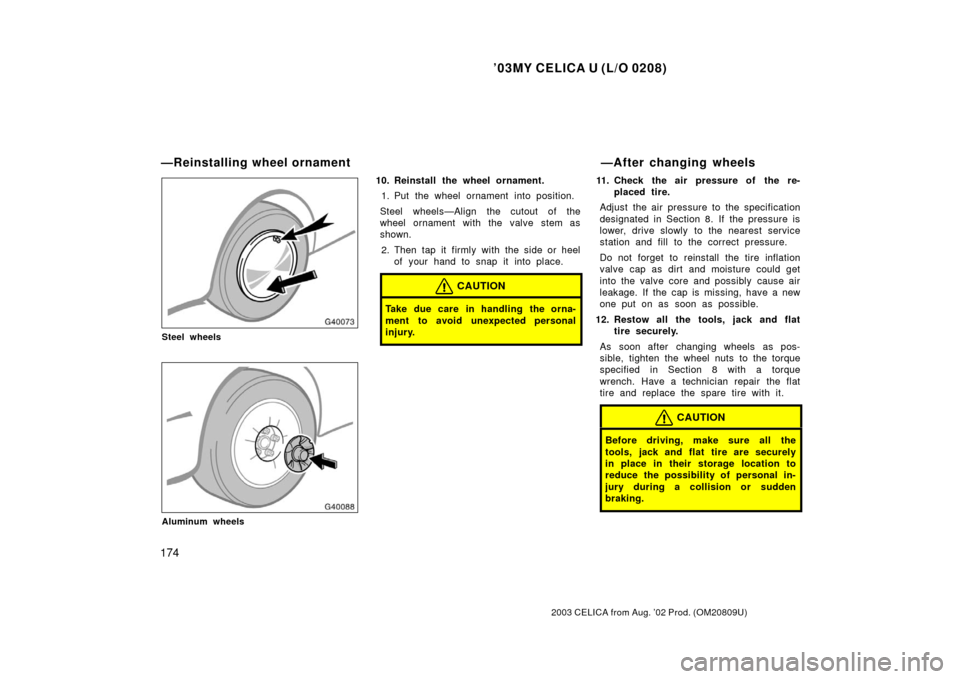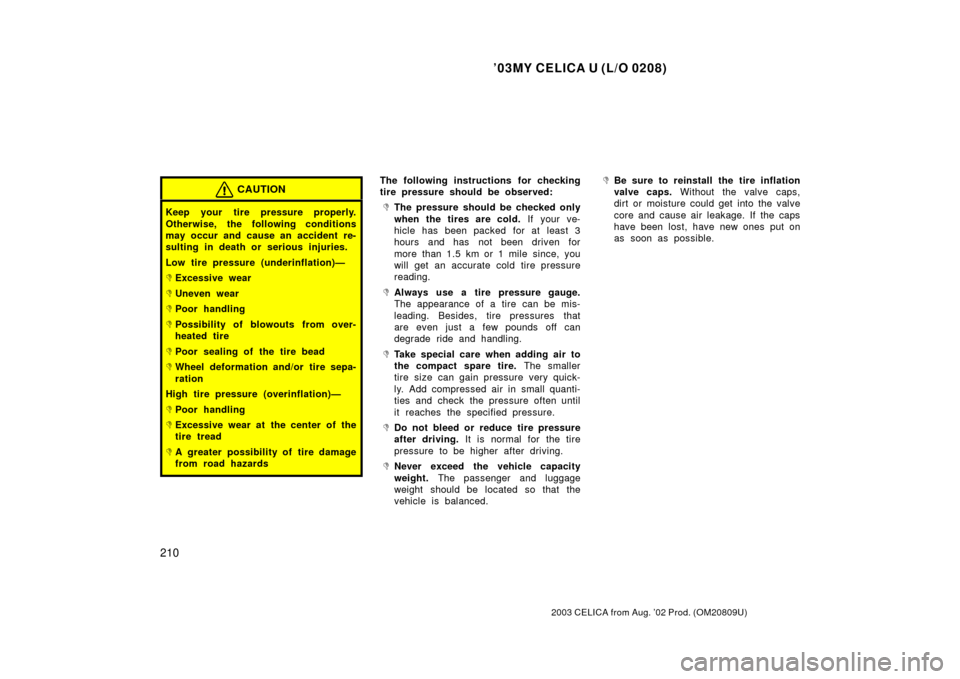Page 170 of 249

’03MY CELICA U (L/O 0208)
166
2003 CELICA from Aug. ’02 Prod. (OM20809U)
Ty p e A
Ty p e B
Spare tire with turning direction indica-
tors (some models)
The spare tires with turning direction
indicators are directional and intended
to be used so that they turn in the
same direction as the turning direction
indicators.
Installing the wheel on the driver side of
the vehicle will not affect tire performance.
If the spare tire is used on the driver side
of the vehicle, it should be used only
temporarily and then replaced with the
correct one.Compact spare tire
The compact spare tire is designed for
temporary emergency use only.
The compact spare tire is identified by the
distinctive wheel design and color and
special wording “TEMPORARY USE ONLY”
molded into the side wall of the tire.
The compact spare tire saves space in
your trunk or luggage compartment, and
its lighter weight helps to improve fuel
economy and permits easier installation in
case of a flat tire. The compact spare tire can be used many
times, if necessary. It has tread life of up
to 4800 km (3000 miles) depending on
road conditions and your driving habits.
When tread wear indicators appear on the
tire, replace the tire.
See also the tire section in Section 7�2
for details on the tread wear indicators
and other service information.
CAUTION
�The compact spare tire was de-
signed especially for your Toyota.
Do not use it on any other vehicle.
�Do not use more than one compact
spare tire at the same time.
�The pressure for the compact spare
tire must be 420 kPa (4.2 kgf/cm2
or bar, 60 psi).
�Do not exceed 80 km/h (50 mph)
when driving with the compact
spare tire.
�The standard tire should be re-
paired and replaced as soon as
possible.
�Avoid sudden acceleration, sudden
deceleration and sharp turns with
the compact spare tire.
Page 171 of 249
’03MY CELICA U (L/O 0208)
167
2003 CELICA from Aug. ’02 Prod. (OM20809U)
NOTICE
Your ground clearance is reduced
when the compact spare tire is
installed so avoid driving over ob-
stacles and drive slowly on rough,
unpaved roads and speed bumps.
Also, do not attempt to go through an
automatic car wash as the vehicle
may get caught, resulting in damage.
With a compact spare tire
Without a compact spare tire
1. Get the required tools and sparetire.
1Jack
2 Wheel nut wrench
3 Spare tire
4 Jack handle
To prepare yourself for an emergency, you
should fam iliarize yourself with the use of
the jack, each of the tools and their stor-
age locations.
—Required tools and spare
tire
Page 173 of 249
’03MY CELICA U (L/O 0208)
169
2003 CELICA from Aug. ’02 Prod. (OM20809U)
To remove the spare tire:1. Remove the spare tire cover.
2. Loosen the bolt and remove it.
Then take the spare tire out of the ve-
hicle.
When storing the spare tire, put it in place
with the inner side of the wheel facing up.
Then secure the tire by repeating the
above removal steps in reverse order to
prevent it from flying forward during a
collision or sudden braking.2. Block the wheel diagonally opposite the flat tire to keep the vehicle from
rolling when it is j acked up.
When blocking the wheel, place a wheel
block in front of one of the front wheels
or behind one of the rear wheels.Steel wheels
Aluminum wheels
—Blocking the wheel —Removing wheel ornament
Page 175 of 249
’03MY CELICA U (L/O 0208)
171
2003 CELICA from Aug. ’02 Prod. (OM20809U)
5. Position the jack at the correct jackpoint as shown.
Make sure the jack is positioned on a
level and solid place.6. After making sure that no one is in the vehicle, raise it high enough so
that the spare tire can be installed.
Remember you will need more ground
clearance when putting on the spare tire
than when removing the flat tire.
To raise the vehicle, insert the jack handle
into the jack (it is a loose fit) and turn it
clockwise. As the jack touches the vehicle
and begins to lift, double�check that it is
properly positioned.
CAUTION
Never get under the vehicle when the
vehicle is supported by the jack
alone.
—Positioning the jack —Raising your vehicle
Page 176 of 249
’03MY CELICA U (L/O 0208)
172
2003 CELICA from Aug. ’02 Prod. (OM20809U)
7. Remove the wheel nuts and changetires.
Lift the flat tire straight off and put it
aside.
Roll the spare wheel into position and
align the holes in the wheel with the bolts.
Then lift up the wheel and get at least the
top bolt started through its hole. Wiggle
the tire and press it back over the other
bolts.Before putting on wheels, remove any cor-
rosion on the mounting surfaces with a
wire brush or such. Installation of wheels
without good metal�to�metal contact at the
mounting surface can cause wheel nuts to
loosen and eventually cause a wheel to
come off while driving.8. Reinstall all the wheel nuts finger tight.
Reinstall the wheel nuts (tapered end in-
ward) and tighten them as much as you
can by hand. Press back on the tire back
and see if you can tighten them more.
—Changing wheels —Reinstalling wheel nuts
Page 178 of 249

’03MY CELICA U (L/O 0208)
174
2003 CELICA from Aug. ’02 Prod. (OM20809U)
Steel wheels
Aluminum wheels
10. Reinstall the wheel ornament.1. Put the wheel ornament into position.
Steel wheels—Align the cutout of the
wheel ornament with the valve stem as
shown. 2. Then tap it firmly with the side or heel of your hand to snap it into place.
CAUTION
Take due care in handling the orna-
ment to avoid unexpected personal
injury.
11. Check the air pressure of the re- placed tire.
Adjust the air pressure to the specification
designated in Section 8. If the pressure is
lower, drive slowly to the nearest service
station and fill to the correct pressure.
Do not forget to reinstall the tire inflation
valve cap as dirt and moisture could get
into the valve core and possibly cause air
leakage. If the cap is missing, have a new
one put on as soon as possible.
12. Restow all the tools, jack and flat tire securely.
As soon after changing wheels as pos-
sible, tighten the wheel nuts to the torque
specified in Section 8 with a torque
wrench. Have a technician repair the flat
tire and replace the spare tire with it.
CAUTION
Before driving, make sure all the
tools, jack and flat tire are securely
in place in their storage location to
reduce the possibility of personal in-
jury during a collision or s udden
braking.
—Reinstalling wheel ornament —After changing wheels
Page 213 of 249

’03MY CELICA U (L/O 0208)
209
2003 CELICA from Aug. ’02 Prod. (OM20809U)
If hot
O.K.Close Open
If hot add If cold
add
If cold O.K.
Check the fluid level through the reser-
voir. If necessary, add automatic trans-
mission fluid DEXRON
�II or III.
If the vehicle has been driven around 80
km/h (50 mph) for 20 minutes (a little
more in frigid temperatures), the fluid is
hot (60 �C—80 �C or 140 �F—175 �F). You
may also check the level when the fluid
is cold (about room temperature,
10 �C—30 �C or 50 �F—85 �F) if the engine
has not been run for about five hours. Clean all dirt from outside of the reservoir
tank and look at the fluid level. If the fluid
is cold, the level should be in the “COLD”
range. Similarly, if it is hot, the fluid level
should be in the “HOT” range. If the level
is at the low side of either range, add
automatic transmission fluid DEXRON
�II or
III to bring the level within the range.
To remove the reservoir cap, turn it coun-
terclockwise and lift up. To reinstall it,
turn it clockwise. After replacing the reser-
voir cap, visually check the steering box
case, vane pump and hose connections
for leaks or damage.
CAUTION
The reservoir tank may be hot so be
careful not to burn yourself.
NOTICE
Avoid overfilling, or the power steer-
ing could be damaged.
Keep your tire pressures at the proper
level.
The recommended cold tire pressures, tire
size and the vehicle capacity weight are
given in Section 8. They are also on the
tire pressure label as shown.
You should check the tire pressures every
two weeks, or at least once a month. And
do not forget the spare!
Incorrect tire pressure may waste fuel,
reduce the comfort of driving, reduce tire
life and make your vehicle less safe to
drive.
If a tire frequently needs ref illing, have it
checked by your Toyota dealer.
Checking power steering fluid Checking tire pressure
Page 214 of 249

’03MY CELICA U (L/O 0208)
210
2003 CELICA from Aug. ’02 Prod. (OM20809U)
CAUTION
Keep your tire pressure properly.
Otherwise, the following conditions
may occur and cause an accident re-
sulting in death or serious injuries.
Low tire pressure (underinflation)—
�Excessive wear
�Uneven wear
�Poor handling
�Possibility of blowouts from over-
heated tire
�Poor sealing of the tire bead
�Wheel deformation and/or tire sepa-
ration
High tire pressure (overinflation)—
�Poor handling
�Excessive wear at the center of the
tire tread
�A greater possibility of tire damage
from road hazards
The following instructions for checking
tire pressure should be observed:
�The pressure should be checked only
when the tires are cold. If your ve-
hicle has been packed for at least 3
hours and has not been driven for
more than 1.5 km or 1 mile since, you
will get an accurate cold tire pressure
reading.
�Always use a tire pressure gauge.
The appearance of a tire can be mis-
leading. Besides, tire pressures that
are even just a few pounds off can
degrade ride and handling.
�Take special care when adding air to
the compact spare tire. The smaller
tire size can gain pressure very quick-
ly. Add compressed air in small quanti-
ties and check the pressure often until
it reaches the specified pressure.
�Do not bleed or reduce tire pressure
after driving. It is normal for the tire
pressure to be higher after driving.
�Never exceed the vehicle capacity
weight. The passenger and luggage
weight should be located so that the
vehicle is balanced.
�Be sure to reinstall the tire inflation
valve caps. Without the valve caps,
dirt or moisture could get into the valve
core and cause air leakage. If the caps
have been lost, have new ones put on
as soon as possible.